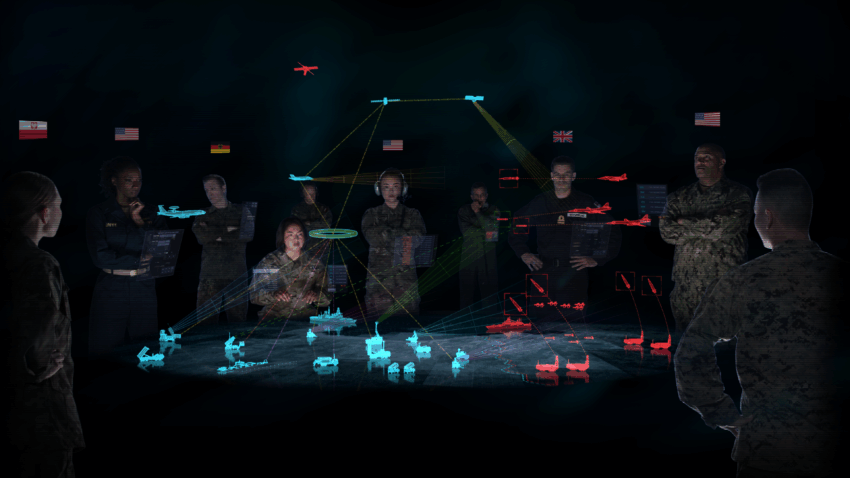The Polish government, who selected IBCS to serve as the centerpiece for its medium range air defense modernization program, declared Initial Operational Capability in December 2024. Poland is the first U.S. ally to field the system. (Northrop Grummon)
RAF FAIRFORD, England — Northrop Grumman is pitching its Integrated Battle Command System (IBCS) to the European Sky Shield Initiative (ESSI), as well as to NATO for its Air Command and Control System (ACCS) replacement effort, a top executive confirmed during the Royal International Air Tattoo.
Speaking to Breaking Defense on July 18, Kenn Todorov, vice president and general manager of Command & Control and Weapons Integration at Northrop Grumman, said the company had “engaged” in conversations with both programs.
“At the request of those program offices, we’ve provided information. We’ve provided virtual demonstrations, not live fire, to be clear. And I think the next steps — I know they’re in an evaluation process. I obviously don’t speak for them and that process — but I think there’s a lot of interest in what system like IBCS might provide, and those decision makers are evaluating the cost and the benefit of the system.
“I think IBCS is a player for both of these [programs],” Todorov asserted.
IBCS is an integration setup that connects sensors and effectors not designed to work together. It’s a system designed to fit into a world where, as Todorov described it, missile threats are only increasing on a global scale.
“We see it every day in Russia, Ukraine, the Middle East, Iran and Israel. The missile defense problem is not going away, nor is it getting any easier,” he said.
Given the continent-wide need for air defenses, Europe and its suddenly growing defense budgets are a logical place to pitch the system. And it already has a landing spot inside the alliance, as both the US and Poland are signed onto the system.
Poland is set to move from initial operational capability to full operational capability on Sept. 16 when they are scheduled to conduct a “live fire flight test across 500 kilometers,” Todorov said.
“[The Poles] recognize the benefits of how it can link sensors and shooters together to have a much more efficient battlespace. And in an era where the adversaries are throwing waves and waves of things at the ‘good guys,’ so to speak, having a system that can see through all of that and make sense of the battle picture is vitally important.”
Todorov hinted at potential interest in the UK, Denmark and Germany down the road.
“The UK is very interested, obviously with their [strategic] defense review that was just released,” he said, confirming he had undertaken conversations “…with some of those folks who are considering systems that will integrate within the UK for the UK defense design.”
Todorov also said Northrop is in talks with Denmark, whom he thinks will be the next country to make a final decision on IBCS.
“The Germans, as well, are very interested in what’s happening in the IBCS. And I think there’s an inter-Europe integration interest within NATO itself, also within NATO to US forces as well. As the US Army’s Program of Record, nations are interested in, if we go to a conflict, being able to work together. And so, all those sorts of elements of integration are included,” he said.
The company’s European push with IBCS is also being supported by an industrial strategy which could see certain physical components produced within European countries themselves.
“We’ve entered into agreements in Germany, with both Diehl Defence and with Airbus, and so if the Germans make the decision to go with IBCS, much of it will be produced locally in Germany in partnership with those companies,” Todorov said, also describing similar agreement with Marshall Aerospace in the UK.
Examples of local manufacturing could include command and control mobile shelters, communication towers and server racks.
But he added: “The vision for IBCS in the future goes into the Cloud. So we’re reducing the form factor of the system itself. Eventually, I would say IBCS could end up on an ‘app’ on a soldier’s iPhone, for example. But we’re not there yet, but something we’re very excited about working in a much smaller firm order factor than what exists today.”
Click this link for the original source of this article.
Author: Andrew White
This content is courtesy of, and owned and copyrighted by, https://breakingdefense.com and its author. This content is made available by use of the public RSS feed offered by the host site and is used for educational purposes only. If you are the author or represent the host site and would like this content removed now and in the future, please contact USSANews.com using the email address in the Contact page found in the website menu.








